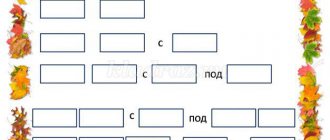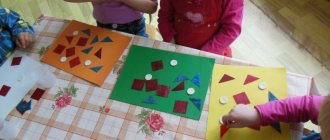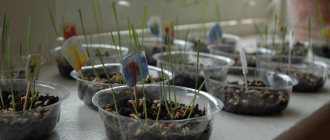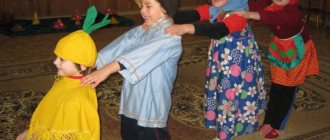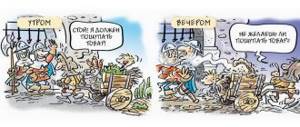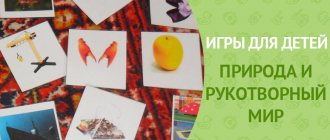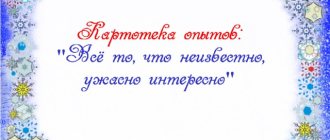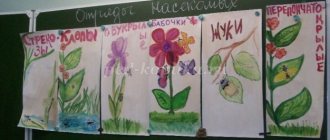Important aspects of the theory
A walk for a child is an effective means of introducing him to the environment of his native place. It is not for nothing that outdoor leisure is considered one of the mandatory components of the educational process in a preschool child care institution.
Goals
The main purpose of the walk is to strengthen the baby’s immunity. Leisure on the street realizes it by adapting the children’s body to environmental conditions. From a pedagogical point of view, children’s stay in the fresh air has 3 directions for goal setting: educational, developmental and educational. In connection with this, the Federal State Educational Standard formulates the main goals of walking in the second junior group:
- prevention of colds and fatigue in children;
- training in nature-appropriate behavior (observing the weather, changing seasons, etc.);
- analysis of weather changes in the outside world;
- development of skills and abilities to record changes in the surrounding world;
- fostering a positive attitude towards nature, which determines the need to take care of it.
Daily walks help strengthen kids
Tasks
In order to realize the goals, at each lesson, that is, at each walk, the teacher must deal with a whole set of problems:
- Demonstration of the beauty and perfection of everything created by nature.
- Getting to know the seasons, as well as the sights of your hometown, the work of adults (cleaning and landscaping streets, building houses, etc.).
- Introducing children to hardening procedures (for example, by washing their feet in cool water in the summer).
- Training the musculoskeletal system through physical activity (running, jumping, swinging legs and arms, etc.), improving the health of the body’s respiratory system.
- Development of self-care skills. For the second youngest group, this is the ability to dress without or with minimal help from an adult, wash, wash hands and dry yourself after a walk, the ability to ask to go to the toilet, blow your nose - before and while being outside.
- Fostering a responsible attitude towards nature and people.
Requirements for the organization
A walk in a junior preschool group lasts no more than 4 hours in 2 doses in winter; in summer, kids spend almost all their time outside and come into the group only to eat and sleep.
The condition for spending leisure time on the street is that the group’s site complies with sanitary standards and the requirements of the organization of the educational process:
- The presence of a landscaped and well-planned area, which has a sandbox, swings and/or climbing ladders, etc. Moreover, all elements of the playground must be checked daily in the morning for the presence of garbage, as well as objects that threaten the life and health of children.
- On the territory of the open area there should be a place specially designated for rainy weather, for example, a gazebo. In winter, adults teach and then help the children sculpt snow figures.
- All equipment (toys, tools - brooms, brooms, etc.) must be safe for the health of children.
- Equipment for games: slides, swings for active fun, balls, skittles. In addition, experienced teaching methodologists recommend compiling 1-2 sets of 4-5 figures, changing every 2 weeks, to clarify and concretize the knowledge gained. For example, one of the sets includes animal toys known to children, which, at the teacher’s request, the children name, describe the structure of their bodies, and show characteristic movements and vocal reactions.
- There should be toys on the site that are appropriate for the age of the children, understandable and in good condition. All equipment for walking must have a clear purpose of use (we play with cars, sweep the area with a broom, etc.).
This is interesting. Detailed information on sanitary standards is presented in SanPiN dated May 15, 2013 No. 26 ABOUT APPROVAL OF SANPIN 2.4.1.3049–13 “Sanitary and epidemiological requirements for the design, content and organization of work in preschool organizations.”
The main requirements for the group site are cleanliness and safety.
Types of walks
According to the priority of goals, the following are distinguished:
- daily morning and evening walks;
- traditional - thematic, built on the principle of dominance of the type of activity of children or logically continuing the theme of the day in the educational process;
- sports - held in the warm season 3-4 times a week;
- targeted - involving observation of natural phenomena or facts of social life outside the site, excursions, conducted 3-5 times a month.
A number of methodological sources present another type of walk - non-traditional. It involves creating an unusual situation for leisure on the street. For example, communicating with a fairy-tale character - a bunny, who came to visit the site and asks the kids to tell him about the signs of autumn, since he himself does not know what it is and how to prepare for it. Sometimes unconventional walks are also called going beyond the boundaries of the site, for example, in order to solve riddles that will be encountered along the way in the form of pinned notes on trees or signs on stones, etc. In other words, in this case, an unconventional walk is a kind of lightning, a quest , for babies . In this case, the teacher, taking on the role of a character, can be dressed in a carnival costume. In form, such a pastime is close to targeted walks, which is why sometimes it is not defined as an independent activity.
Non-standard walks are sometimes called targeted or role-playing walks
Preparing to go to the site
To prevent children from getting tired before going outside and overheating, they should be collected outside in a certain sequence:
- Children clean their nose and go to the toilet.
- Some children (who do not know how to dress themselves), under the guidance of a teacher, put on their shoes and check the correct order of equipment.
- They go outside.
- The assistant teacher takes the remaining children to the locker room, performs hygiene procedures with them, then helps them get dressed and sends them outside to the first teacher.
- The kids return from their walk in the same order.
This is interesting. Children who feel unwell dress with the second group and return with the first.
The main task of the preparatory stage of the walk is to dress the children for the weather
Walk structure
Outdoor leisure is divided into several stages.
An important point: the components of the walk can be implemented in different sequences. For example, on hot days, children first work: they fill the inflatable pool with water, and only then swim, that is, play. But no matter how the structural elements of a walk are combined, it must be completed with a decrease in physical activity, that is, walking, breathing exercises.
Observations
This stage involves recording and analyzing changes in nature or people’s lifestyle. For this purpose, the following objects are considered:
- animals and plants;
- rain, snow, wind, etc.;
- a person’s work activity (for example, a janitor sweeping leaves or clearing snow on a playground).
Observations in the second younger group can be:
- short-term (to form ideas about the shape, size of objects, their position in space and color);
- long-term (to demonstrate the change of seasons, changes in nature - trees turn green in the spring and turn yellow in the fall, etc.).
The sequence of obtaining information and analyzing it is proposed as follows:
- we establish the facts (together with an adult who draws the children’s attention to one or another object of reality, for example, after rain, the sand in the sandbox is wet);
- we connect elements for one observed object (leaves turn yellow, become dry, fly off), etc.
- we accumulate similar facts (yellow leaves, wind, frequent rains) and combine what we heard and saw into a single semantic block;
- we draw conclusions together with the teacher (autumn has come).
More information about observations in junior groups can be found in our article - Organization of supervision in junior groups of preschool educational institutions.
In the second younger group, the observation stage occurs with the direct participation of the teacher, since the children do not yet have sufficient independence skills in such activities
Work
This type of activity teaches the child responsibility for completing the assigned task. The child must learn to choose one or another area of activity, trace the order of operations and select (together with an adult) the right tool.
- Garbage collection. Such a task is not cleaning in the literal sense of the word, because this is the responsibility of the janitor, and children rather imitate his actions. And, nevertheless, the kids will agree with pleasure to collect dry twigs from the territory or do some cleaning - to put things in order in a box with outdoor toys.
- Watering flowers on the site. Kids will enjoy doing housework. To do this, you can give them toy watering cans, or even large ones, but only by filling them 1/6 full.
- Participation in making a bird feeder. The children's task is to find in books an example of what this design should look like.
- Raking snow with shovels and autumn leaves with brooms.
When collecting autumn foliage, you can combine work activity with observing the variety of leaf shapes and colors
Games
Of course, children of any age are closer to outdoor games, especially on the street. In this case, the choice of fun is determined by weather conditions. So, in spring and summer it can be tag, hide and seek, football, and also games with water. In slushy weather, it is better to stop at something calmer, for example, a ring thrower. It is worth noting that in the second junior group, children begin to show interest in team games, in contrast to the first junior group, when they played not together, but side by side.
Typically, children learn 2-3 games every month.
In the second junior group, children learn to play in pairs and as a team
Video: play activities during a spring walk in the second junior group
Individual work
The teacher's skill lies in the fact that all children must be involved in one or another type of activity. As for walking, 99 out of 100 kids love spending time outside. So half of the task has already been solved. In individual work, the baby’s temperament should be taken into account. Some will be interested in playing ball with other kids, while others will be interested in stepping over log obstacles. In addition, there are a number of children who are wary of sports. Perhaps they are much more interested in chasing butterflies.
Individual work involves the interaction of the teacher with one child and with a small group
This is interesting. An evening walk (after a nap) involves communication between the teacher and parents, so observation and work activities are not included in it.
Table: card index of walks (fragments)
| Subject | Activity | Content | Tasks |
| Our site | Observations of objects in the immediate environment | Arriving at the group site, with the help of an adult, examine the objects located on the site, highlight the features of the objects, their qualities and properties. |
|
| Poems, riddles, proverbs | We walked, walked, walked, we found something... We looked, examined it and moved on. | Observing objects along the way. | |
| Outdoor games with running for spatial orientation | Outdoor game "Birds are flying." Children - “birds” sit on benches placed behind the drawn line. To the words of the teacher: “Ay, the birds have flown!” Birds fly all over the site, wherever they want. In response to the teacher’s words: “The birds have flown to their nests,” the children hurry and sit on their chairs. The teacher names the most dexterous and fastest bird, which was the first to fly to its nest. The game repeats itself. |
| |
| Stand alone games | Independent activity with external material of the children's choice. | To develop children's desire to play independently. | |
| Individual work | Develop the ability to walk behind each other while holding on to a rope. | Develop basic movement skills. | |
| Work | Putting toys in a basket. | To instill in children a desire to help adults. | |
| Transport | Monitoring cars passing by the kindergarten | Draw children's attention to the road with passing cars. Find out from the children what kind of cars they know (truck, car, bus...). Disassemble the car into parts (wheel, steering wheel, body). What color was the car? | Strengthen knowledge about transport. |
| Poems, riddles, proverbs. |
| Give the concept of transport through poems and riddles. | |
| Outdoor games with running for orientation in space | Outdoor game "Sparrows and a car." Children stand behind a line drawn on the ground or marked with sticks - this is the house. The teacher is holding a hoop on the opposite side. Children - “sparrows” jump over the line and run in different directions around the playground. When the teacher says, “The car is moving, fly to the nest,” the little sparrows run into the house. |
| |
| Stand alone games | Independent activity with external material of the children's choice. | To develop children's desire to play independently. | |
| Individual work | Continue throwing into the distance with your right and left hands. | Develop distance throwing skills. | |
| Labor activity | Removing snow from the area. | To develop in children a desire to help the teacher. |
Observations of birds at the feeder in the younger group
Card index of bird observations on a walk for children of the 1st junior group.
Description of the material : this material is intended for teachers of children of primary preschool age. Can be used as additional information for walks. Observation “Who flew to the feeder” Objectives: - introduce the birds that fly to the feeder - consolidate knowledge about the appearance of birds - involve wintering birds in feeding
Observation progress
Artistic word: In the snow, like on a page, Pigeons and titmice are writing, A flock of bullfinches is writing, A gray sparrow is writing, Letters to Petya and Andryushka, To make feeders (A. Taraskin) Conversation: Guys, have we made bird feeders?
What are feeders for? Who will we feed? Let's pour some bread and move away. Let's see what will happen: Who flew to the feeder? Who knows what these birds are called? That's right, these are sparrows. What are sparrows doing at the feeder? Why do we feed birds? That's right, it's winter, it's cold outside and the birds have little food. We help them. We feed them. Do you think the bird likes our treats? Well done to you! Let's not forget to feed the birds every day. Observation “Pigeons flew to our feeding trough” Objectives: -introduce pigeons -encourage the desire to observe the behavior of birds and take care of them -consolidate knowledge about the structure of birds Observation progress: Conversation. What kind of birds flew to the feeder? That's right, these are pigeons. Tell me, are they big or small, like sparrows? That's right, they are big. What do pigeons do? That's right, they are pecking at the seeds. And what do they bite? Of course, with a beak. Show me how they bite. Now listen to how the pigeons talk. They coo. Listen to a poem about pigeons. Literary word: I extended my palm - There are crumbs of bread on the palm of my hand. The doves flew in and boldly took the bread from your hand. They walked importantly side by side, cooed among themselves, everyone carried on their own conversation, so that they could still find Piudunen M. for dinner. We look after the birds in winter, help them get food. And of course we don’t forget that birds should not be offended. Observation “Sparrows and crows” Objectives: -introduce the sparrow and the crow -teach to distinguish them by color and color -maintain interest in the life of birds -involve them in feeding Progress of observation Conversation. Where is our feeder? Why is it needed? That's right, to feed the birds in winter. Let's see if there is food in the feeder? No. Let's pour some food and see who comes. What kind of little brown bird flew to our feeder? Yes, it's a sparrow. Sparrows are small, brown birds that fly in flocks. Show me how sparrows fly? What are sparrows doing at the feeder? That's right, they peck at grains and bread crumbs. Show them how they bite. Artistic word Sparrows, Little gray feathers! Peck, peck the crumbs from my palm! No, they don’t peck you from your palm and don’t let you pet them. How can we get along so that we can pet you? Egorov S. What kind of bird is this that flew to our feeder? Children's guesses. Is she bigger or smaller than a sparrow? That's right, more. This is a crow. It is large, black and gray. She almost always flies alone. She is also hungry in winter. What is the crow doing? That's right, she sits on the feeder and pecks at the grains. But she took the bread and flew away. Artistic word -Carrr! The crow screams. Karrr! I'm leaving for the market! Little crows, don't fight! And wait for me in the nest! N. Berestova How does a crow scream? That's right, Carrr. Repeat one more time. Carrr. Guys, who did we see at the feeder today? That's right, a sparrow and a crow. Birds are cold in winter. We help them, take care of them. Observation “Titmouse” Objectives: - clarify ideas about tits - consolidate knowledge about the appearance of tits - encourage the desire to help birds Progress of observation Conversation. Guys, today I brought an unusual treat for the birds. Look, do you know what this is? Shows lard. This is lard. Tit birds love lard, but it should not be salty. Let's hang it at our feeder and wait for the tits. Look, the titmice have flown to us. Tell me who came to us? Titmouse. Tits are small birds, you can distinguish them by their yellow breast. What kind of breast do they have? That's right, yellow. Watch how the titmouse jumps. Show me how she jumps. Literary word A little bird has a yellow breast, A cheerful titmouse has many friends, Children help her get through the winter, Everyone sings the titmouse's song: Shadow-shadow-shadow! Shadow-shadow-shadow! Ah, what a good day! V. Miryasova Observation “Bullfinches” Objectives: - to form an idea of the birds that fly to us in the winter - to explain that all birds in winter need help - to clarify knowledge about the appearance of bullfinches Progress of observation Literary word In winter, there are apples on a branch! Collect them quickly! But suddenly the apples flew up! After all, these are bullfinches! Conversation. Look what a beautiful bird has flown to us. This bird is a bullfinch. There is a gray vest on the back, a bright red breast, and a black cap on the head. The wings are “dressed” in black gloves with a white stripe. Bullfinches fly to people in the hope that they will be treated to seeds. Bullfinches click pumpkin and watermelon seeds with pleasure. We must remember to feed the birds. It is difficult for them to find seeds under a thick layer of snow. People come to the birds' aid. We call birds feathered friends. They are feathered because they grow feathers.
We recommend watching:
Summary of GCD in the junior group “How to take care of your teeth?” Summary of educational activities in the first junior group on the topic “Butterflies” using ICT Summary of a lesson on modeling in a junior group A lesson on describing toys in the junior group of a kindergarten
Similar articles:
Synopsis of a physical education lesson in the junior group “Spring Puddles”
Summary of a lesson on speech development and modeling in junior group 1
Summary of educational activities on cognitive and speech development in the 1st junior group
Summary of a lesson on health conservation for the second junior group
Summary of an art lesson in junior group 1
Walking time plan with examples
In the second younger group, each stage of the walk (both in the morning and after a nap) lasts from 3 to 5 minutes, that is, only about 15–20 minutes. The rest of the time (40–60 minutes) the children spend in independent activities.
Theme: "Spring"
- Observations of weather conditions - 3 minutes. Discussion of air temperature (cold, cool, warm), wind strength (windy - calm), precipitation, etc.
- Game activity - 5 minutes.
- Game “Streams by the Lake” (task: learn to run after each other, stand in a circle when given a signal). The teacher says: “Streams” - the kids run after each other, when they hear the word “lake” - they hold hands and stand in a circle.”
- Game “We are bears” (task: learn to imitate the gait of a bear). Children walk in a circle with their legs spread wide apart.
- Individual work - 3 minutes. Continue working on training kids to maintain balance when jumping on bent legs.
- Labor activity - 3–4 minutes. Clearing the playground of snow residues with shovels.
Theme: "Wind"
- Wind observation - 3 minutes. Note the speed at which the clouds float across the sky, use the plume to determine the strength of the wind (if the ribbons are fluttering strongly, then the wind is strong), etc.
- Labor activity - 3 minutes. Collect twigs broken by the wind into buckets.
- Game activity - 3 minutes. Game “Sunny Bunnies” (task: learn to play together, follow the rules of the game). The teacher releases a sunbeam with a mirror, the children, on command, begin to “catch” it; whoever managed to cover it with their palm wins.
- Individual work - 4 minutes. The teacher reads the fairy tale “Turnip”, and the children, having heard the name of this or that character, perform certain actions agreed upon in advance, or do some manipulations with the ball, plumes, etc.
Video: how to make a plume from bags
Walk-event in junior group 1 “Bird watching”
Bird watching in winter.
Prepared by the teacher of 1 ml group
Ivanova Anna Borisovna
Walk - event in 1st junior group
Target:
Expanding children's understanding of birds and their appearance.
Tasks:
Educational:
1. Cultivate a love for birds and a caring attitude towards them.
Educational:
1. Expand and consolidate children’s ideas about birds, their appearance (two legs, two wings, a beak on the head, eyes, the body is covered with feathers), bird habits.
2. Summarize and consolidate the ideas children have received about their area.
3. Reinforcing the concept of big and small.
Educational:
1.Develop attention, memory, observation skills.
2. To develop children’s desire to play outdoor games with the teacher.
3. Activate children's vocabulary.
Vocabulary
work
: bird, head, tail, wings, birds fly, peck, big, small.
Methodological
techniques
: demonstration, explanation, artistic expression, consideration, gaming techniques.
Preliminary
work with children:
Looking at the album “Birds”, reading poems about birds, listening to “Birds and Chicks” music. E. Tilicheeva; learning the song "Bird" music. Rauchwerger, lyrics by A. Barto, modeling grains for birds.
Visual materials, equipment
: Bird figures, 2 hoops, bird emblems for outdoor play, bird food, spatulas, molds, scoops.
Progress of
the walk
Go out with the children for a walk, look at the birds that have flown to the site.
Place bread crumbs in the feeder. Watch the birds peck at food.
—Educator: U
Birds have two legs, two wings, a beak, and they peck crumbs.
Birds are cold and hungry in winter, so we need to take care of them and protect them.
Ask the children questions: What do birds do? What birds? What do birds have? (Children's answers).
Labor activity
Help the teacher clear the area of snow.
P. game
“Naydinas”
(orientation on the site)
Educator: Guys, birds hid in the area
Where are the birds? (children look for birds and name objects that are on the site)
P. game
“Birds are flying.”
The birds flew in, small birds, kept flying, kept flying, flapping their wings. They flew onto the path and pecked the grains. Children wear the emblems of the birds they like. At the teacher’s signal, the birds “fly” - the children run around, pecking at the grains.
Individual
work on movement development
: “Catch the bird” - jumping on two legs up to an object.
D\game " Big, small "
Children put bird figures in hoops: in a red hoop for large birds, in a blue hoop for small birds.
Independent activity
children with take-out materials: spatulas, molds, scoops.
Result:
Educator:
Did you guys like playing with the birds? What birds flew to our site? What did the birds do? (children's answers)
Table: example of a walk summary
| Author | Elena Maksimova, teacher at MBDOU No. 83 “Sokolyonok”, Kaluga |
| Name | Summary of a walk in an unconventional form in the junior group “Fairy Tale” |
| Program content |
|
| Progress of the walk | Going out for a walk, the teacher tells the children that he saw something interesting in the bushes. The children find a toy there. V.: “This is not a simple toy, but a magical one. She will help us find the entrance to the fairy tale. Do you want to go on a fabulous journey? The children agree. V.: “But first you need to guess the riddle: seven of them lived in a hut, until a gray wolf made its way to them.” (Seven little goats) Children find themselves in a fairy tale through a “magic” window. V.: “Oh, guys, where are we? Yes, straight to the wolf's lair! We’ll have to run away from him now!” Outdoor game "Wolf and kids". V.: “So we ran away from the evil wolf. Let's move on. Whose house is this on our way?” (Baba Yaga, Snow White, Three Bears, etc.) V.: “Yes, this is probably the house of some fairy-tale hero. A beautiful house, but for some reason very dirty. Its owner probably went away on a visit, and the house became boring and dusty without her. Shall we help the owner? The children are cleaning the house. V.: “Well done, children! The house is just sparkling now, let's play in it a little." Role-playing game "Let's go for a visit." V.: “Guys, look how beautiful the sky is in the fairy tale. What color is it? What shape is the cloud?” Children describe the clouds and the color of the sky. V.: “Guys, visiting is good, but home is better! It's time for us to head back." Children go to the group. |
| Quote from: https://www.maam.ru/detskijsad/konspekt-progulki-v-netradicionoi-forme-v-mladshei-grupe-skazka.html | |
Summary of a walk in the second junior group in winter according to the Federal State Educational Standard
Summary of a winter walk in the younger group on the topic “We are not cold in winter”
Goal: to introduce children to the new season - winter. Objectives: 1. To form first ideas about winter and its signs;
2. Develop interest in phenomena occurring in nature; 3. Teach children to walk and run in deep snow; 4. Develop accuracy, determination, perseverance; 5. Develop coordination of movements, continue to develop the skills of jumping over obstacles; 6. Develop the ability to experience joy from a walk; 7. Foster positive attitudes towards collective activities, cultivate friendliness and determination. Progress of the walk
Children and their teacher go out onto the playground. Conversation with children. — Guys, what time of year is it now? Why do you think so? — What clothes did you and I wear for our walk? The teacher pays attention to the children’s clothes and explains that everyone dressed warmly today, tied scarves, put on mittens, warm hats - this is because winter has come and it has become cold. - Guys, look how much snow there is. And how the snow shines. On the fence, on the porch, everything shines and everything is white. There is no free place, there is snow everywhere. Watching snowfall, showing how snowflakes swirl in the air. - Indeed, it’s very beautiful on the site. — Let’s together name all the properties of snow (white, cold, fluffy, light, you can sculpt from snow). Let’s remember the rule: you can’t eat snow, you can get sick. Walking and running in deep snow. Educator: - Guys, today I want to invite you to walk and run in the deep fluffy snow, feel how hard it is. You also need to raise your knees high (walking in deep snow, raising your knees high - 2 laps around the area). - And now, guys, let’s run together through the snow (running - 1 lap, and now let’s follow in our footsteps. Educator: You’re winter-winter, You’ve come with the frosts. The wind howls, the blizzard blows, It sweeps along the street. What a winter! Let's play the game "Yes, yes, yes; no, no, no!" (sedentary game) Educator: - I will tell you about winter, and if I'm right, you clap your hands and say: "Yes, yes, yes “, and if I’m wrong, you shake your finger at me and say: “No, no, no!” - It snows in winter. (Yes, yes, yes). - In winter, you don’t need to wear a hat and mittens (No, no, no ) - In winter, the birds are warm and they sing songs (no, no, no) - Who sings and howls in winter? (Wind: V-v-v) - Is it cold, frosty in winter? (yes-yes-yes) Outdoor game "Frost" ". Goal:
to instill in children the ability to perform characteristic movements.
The teacher says in a rough voice: - I am Frost, Red Nose. I have a beard. I am looking for animals in the forest. Come out quickly! Come out, bunnies! Children jump towards the teacher like bunnies. Educator : I'll freeze! I'll freeze! The teacher is trying to catch the children. The children run away. The game repeats itself.
Every time “Santa Claus” invites new animals (bear cubs, foxes, etc.) to come out of the forest - Guys, let’s see what kind of snow it is today.
Children take shovels, pick up snow and throw it up (the snow either scatters in a light cloud) - loose, (or does not scatter) - wet. Finger gymnastics: Like on a hill - snow, snow. (We raise our hands up, imitating falling snow) And under the hill - snow, snow. (hands down, bends) And on a Christmas tree - snow, snow. (We connect our fingertips, “Christmas tree” ) And under the tree there is snow, snow. (tilts) And a bear sleeps under the snow. (We put our fists on the head, the “ears” of the bear) Hush, hush - don’t make noise! (We bring a finger to our mouth, we threaten) Work activity: - Guys, You have already noticed that there is a lot of snow. I suggest you all work together to remove the snow from the area. — We take the snow on a shovel and carry it into a common pile. We clean the area and do useful work. Cleaned up, well done! Now you can work out. Games with shovels. - Now let’s take the shoulder blades and play with them. We squat together with the shoulder blade and hold it in our hands. We lift up, stand up (4-5 times). Now put the shoulder blade in front of you and jump over it on one leg (5-6 times). The shoulder blades lie in front of you, and you try to jump one after another over all the shoulder blades in turn (2 minutes). Shoulders raised high up, we walk around the site and breathe fresh air through our noses (5-6 inhalations and exhalations on command) Result: - Guys, what time of year is it now? — Did you like playing with Frost? - What did you like most? -Aren't you cold? We are not cold in winter because we played, worked, ran, and had fun.
We recommend watching:
Summary of winter fun on a walk “In the Winter Forest” for children of primary preschool age Winter walk with children of the younger group. Notes Notes on sensory development in the junior group on the topic: Winter Winter walk for children of the 2nd junior group of kindergarten. Abstract
Similar articles:
Summary of a winter walk in the junior group of kindergarten on the topic: “Birds in winter”
Summary of a game lesson for young children on the topic: Winter
Long-term planning of walks in the second junior group
The theme of outdoor leisure in kindergarten is traditionally selected according to the time of year in the context of the themes of the educational process as a whole. Typically there are 10–13 topics per month.
The theme of the walks echoes the themes of other classes
The design of long-term planning is determined by the methodological council of the preschool institution.
Table: example of a long-term plan (fragment)
| Author | Yuliya Erokhina, teacher at MBDOU CRR/DS No. 3 “Zvezdochka”, Anapa | |
| Name | Long-term planning of walks in the second junior group | |
| Month/date | Subject | Content |
| March | Signs of early spring |
|
| Watching the sky |
| |
| Surveillance of passing vehicles |
| |
| Roadway surveillance |
| |
| Icicle watching |
| |
A walk in the second junior group is an important element of the educational process, which allows one to more fully realize the educational, developmental and educational goals of methodological work with children. In addition, outdoor leisure is the most accessible way to harden a child’s body. The main thing is that being in the fresh air, so interesting and exciting, is very popular with kids.
Lesson summary “Observing a cat” (junior group)
Pavlova Tatyana Petrovna,
teacher,
MBDOU "Kindergarten No. 54",
Cheboksary, Chuvash Republic
LESSON SUMMARY “Observing a cat” (junior group)
Program content:
1. Form an idea of the cat’s appearance and some of its habits.
2. Enrich children's vocabulary with words denoting signs of appearance and action.
3. Foster a caring attitude towards animals.
Equipment: cat (live), screen, cat (doll), treats for the cat (carrots, candy, sausage, milk), educational game “Confusion”.
Methodical techniques: verbal, visual, game.
Progress of the lesson:
The teacher brings the cat into the group and draws the children’s attention:
- Guys, look who came to us? Who is this?
Children: Cat, cat.
Teacher's story about the cat:
- It's a cat. His name is Barsik. He's big and fluffy. The cat has soft fur (invites the children to stroke the cat). He is very affectionate, loves to be petted, but if he gets angry, he can scratch. Look how sharp his claws are.
The kitten's paws are soft pillows,
And inside the scratches are sharp toys.
Why do you think a cat might get angry?
Children: If you pull the tail, if you hit the mustache.
Educator: Look what a beautiful face the cat has, big green eyes, long whiskers, ears.
The children, together with the teacher, examine the cat and stroke it.
— Guys, I prepared a treat for our cat. Look what I prepared.
Children's answers: Carrots, milk, candy, sausage.
- What should we treat our cat?
Children: Candy, milk, carrots, sausage.
Educator: Let's give Barsik a treat and see what he chooses. (The cat eats and the children watch).
Educator: What did Barsik like?
Children: Milk, sausage.
Educator: Why didn’t the cat eat candy and carrots?
Children: Didn’t like it, doesn’t want it, doesn’t taste good.
Educator: That's right, cats don't eat candy or carrots.
From behind the screen you can hear crying and meowing (the cat Tsap-scratching appears).
- Hello guys!
- Hello, Tsap-Tsarapych. What happened to you? Why are you crying?
Tsap-Tsarapych: The guys drew me a portrait of me and a portrait of my friend the bunny, but they drew them on different pieces of paper. Look here: the ears are on one, the tail is on the other, the eyes are on the third, the paws are on the fourth. The bunny was also drawn. I mixed everything up, but I can’t put it all together. Maybe you can help me?
Teacher and children: Let's help!
The guys, together with the teacher and Tsap-Tsarapych, put together pictures. The teacher draws the children's attention to the fact that the cat has short ears, and the hare has long ears; The hare has a short tail, and the cat has a long tail. Tsap-Tsarapych thanks the children for their help.
Literature
1. Zolotova E.I. Introducing preschoolers to the world of animals. - M.: Education, 1988.
2. FROM BIRTH TO SCHOOL. Approximate general educational program for preschool education / Ed. N. E. Veraksy, T. S. Komarova, M. A. Vasilyeva. - M.: MOSAIC-SYNTHESIS, 2014.
3. Nikolaeva, S. N. Environmental education of younger preschoolers. A book for kindergarten teachers. - Moscow: Mosaic-Sintez, 2004.
